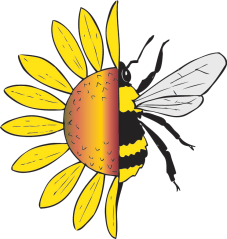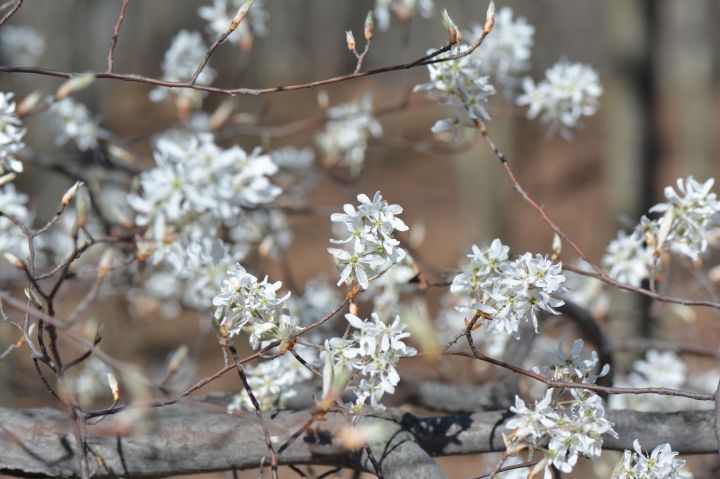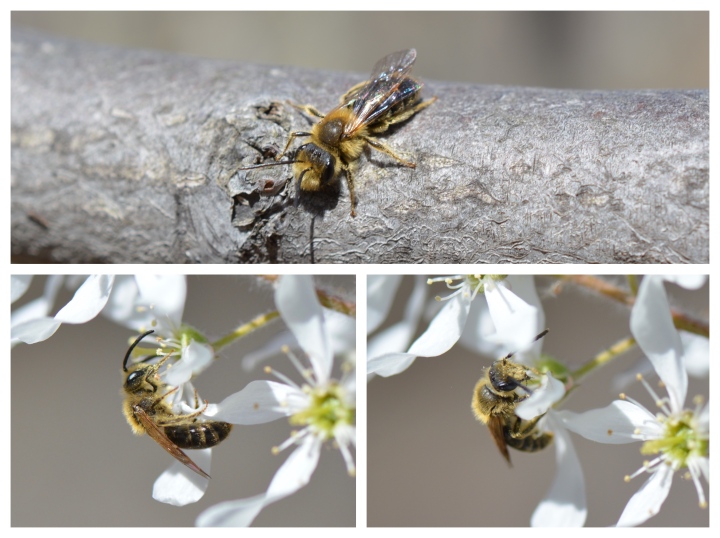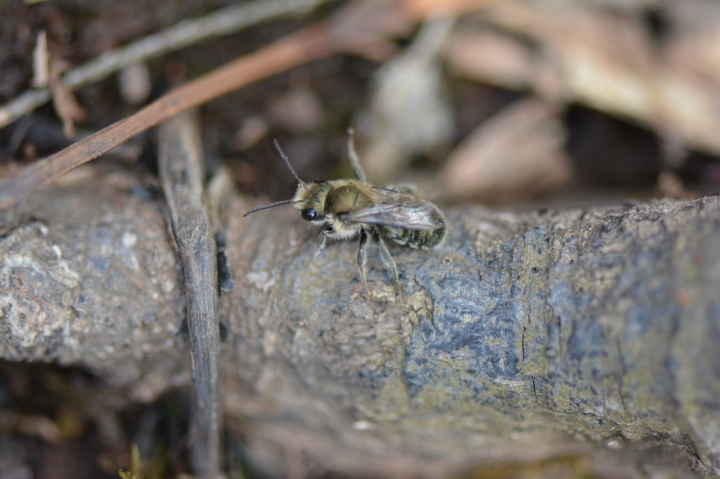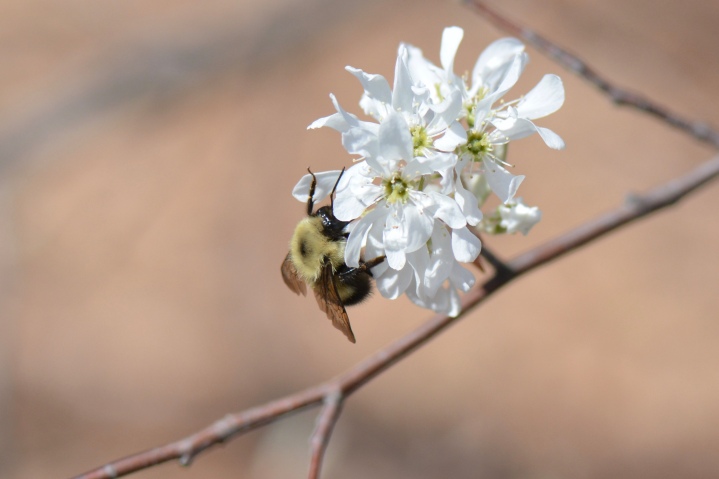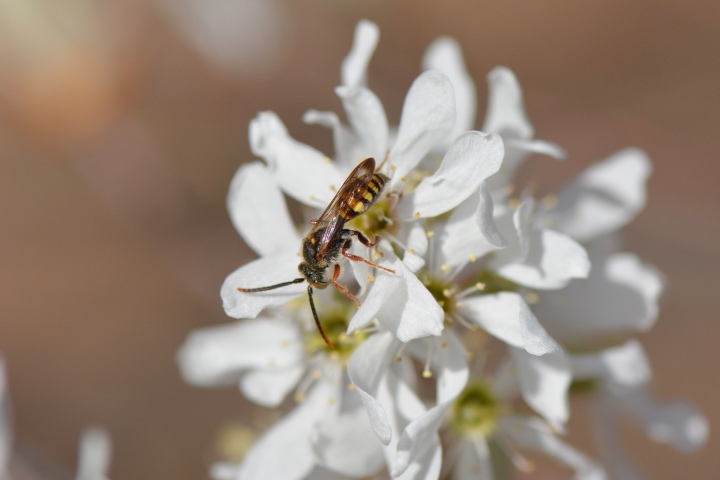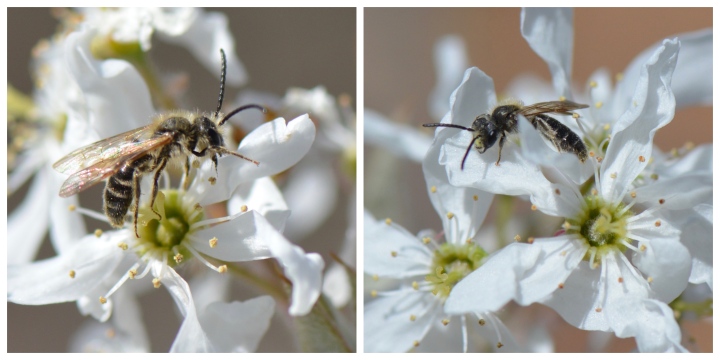Winter in the North is long and cold forcing the frost to penetrate deep, freezing the ground solid as a rock. The serviceberry, a small flower bearing tree, signals the ground has thawed, a sign post to people it was time to bury their loved ones that had died the previous winter. Funeral services commenced with springs advent and the tree was aptly named the serviceberry. From cemetery’s across the North Country families and friends looked to the hills to see the white blossoms interspersed among the forest, a reassuring reminder of the cycles of life and from death comes life.
Spring is the season for renewed life and new generations of pollinators emerge to partake in all that is offered by the delicate flowers of the serviceberry (Amelanchier spp.) Some of the first bees to emerge in the spring are mining bees. This solitary bee, from the family Andrenidae contains 400 different species of bees in North America. In fact, field identification of individual species can be rather difficult and reserved to melittologist’s (entomologist’s who study bees). Regardless of the species, numerous members of this family seem to levitate to the highest branches where a small cloud of flying insects can be seen hovering to and fro between flowers. Males are seen harassing females as they busy themselves collecting pollen and nectar to feed a new generation of bees. Mining bees as their name suggests are ground nesting bees and as with all solitary bees, every single female is an egg layer. They lay an egg and provision the egg with “bee bread”, a mixture of pollen and nectar. The eggs hatch and grow underground to emerge the following spring.
Another solitary bee that is an active visitor of the serviceberry are mason bees from the family Megachilidae and the genus Osmia. These bees collect pollen on scopa hairs on the bottom side of their abdomens and lay their eggs in hollow tubes or holes in trees. They use mud to create partitions between their brood cells in the their nesting chambers. These spring bees are extremely efficient pollinators and 250 bees are as efficient as a hive of honey bees. They produce a single generation a year and once their eggs are laid the adult bees die. The new generation emerges the following spring where they faithfully visit the serviceberry, apples, raspberries and strawberries.
Throughout the leafless forest it is easy to see the large queen bumble bees (Bombus spp.) in flight, hungry and awake after a long winters hibernation. The bumble bee is one of the few indisputable social bees native to North America. Social bees have a queen, the sole egg layer in the colony. She is a frequent visitor of the serviceberry one of their favorite woodland flowering trees. When not visiting flowers, the queen is on the look out for a place to begin her new found colony of worker bees that will will grow to 50 to 200 bees depending on the species. Bumble bee colony’s are often located in old abandoned mouse nests. The worker bees are always smaller than the queen and their size can vary depending on how much honey and pollen they were fed as developing brood.
The serviceberry is represented by many individual species and is a member of the rose family (Roseacea). One of the most common species in the Northeast is Amelanchier arborea and can be found growing in a variety of habitats including dry upland slopes. Though not commonly grown commercially Amelanchier alnifolia is grown commercially on 900 farms over 3,200 acres of production in Canada where it is called “saskatoon berry”. This new crop is similar to blueberries in size, shape and flavor but due to lower moisture content they provide higher amounts of calcium, natural fiber, proteins and carbohydrates. These berries have potential to become an increasing significant food source in the future.
The fervent work of spring pollinators is June’s reward when the serviceberry ripens. The ever vigilant observer of nature may be fortunate enough to stumble upon the ripe “Juneberry” before the birds feast on this coveted fruit, favored by flocks of cedar waxwings. Listen for their soft whistle and you will certainly find a serviceberry. The fruits ripening coincides as the shad migrate up river to lay their eggs, hence the serviceberry, also commonly known as shadbush, alerts folks in many locales to grab their fishing poles and head to the river. And so the circle of life continues.
